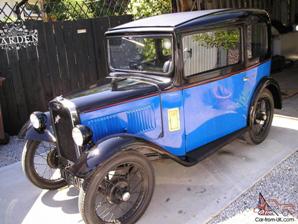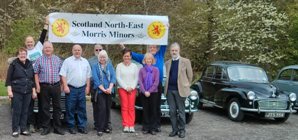
 |
Austin Seven and Morris Minor - Power to weight |
|
When I began writing this page it was intended to just consider the power to weight of the Austin Seven. I introduced my Morris Minor as a comparison, but have ended up writing more about the Minor than the Austin. Anyway, I am equally proud of Katie, my 1933 Austin Seven and Morag, my 1959 Morris Minor. I hope you enjoy reading this page. The pre-WW2 Austin Seven is a car which can truly claim to have changed the course of motoring history. It was a cheap small car that saved the Austin car company from bankruptcy when it was launched in 1922. By the end of production in 1938 more than 291,000 cars, in a wide variety of body styles had been built at Longbridge. A further 100,000 were built around the world under license. Amazingly, for a car which had not been made for more than eighty years, in late-2020, there were 12,310 on the world-wide register of surviving cars. DVLA in the UK alone, has 2,333 roadworthy cars registered and a further 467 on SORN. (Statutory off-road notification). The Austin Seven was particularly noteworthy as the first mass-market car in the world to pioneer the arrangement of accelerator, brake and clutch which has subsequently been followed by all modern non-automatic vehicles - unlike the centre throttle layout favoured at the time. With its centre mounted handbrake and gearstick this makes it particularly easy for a modern driver to adjust to driving an Austin seven. In addition, there were brakes on all four wheels – something that had largely been confined to racing cars up until then. The Seven was also noteworthy for the number of other vehicle marques which were derived from it. The Swallow variant became the first Jaguar car. When licensed as the Dixi in Germany, it became the first car to bear the BMW badge. Sevens were shipped to Australia in kit form to become the first Holden car. American Bantam, which is credited with the design of the WW2 Willys Jeep, started off building Austin Sevens under licence. Nissan in Japan copied the Austin Seven to build its first Datsun but did not pay for a license. Sir Herbert is thought to have decided not to sue Nissan as Japanese car production was not expected to amount to much. Versions of the turbocharged Austin 750cc engine in ultra-light weight bodies were the basis of record-breaking speed trials in the late 1920s and early 1930s, with 120mph being achieved in 1934. The first racing car built by Bruce McLaren was developed from an Austin Seven, as was the first Lotus built by Colin Chapman. Lola founder Eric Broadley, F1 designer Tony Southgate and aerodynamicist Frank Costin all began with work on Austin Sevens. The sporting 750 Motor Club grew to nurture the talents of young engineers who did more to shape modern motor racing than the likes of Enzo Ferrari or Ettore Bugatti. My own car is illustrated. VT9016 is an RP 4-seat "box" saloon first registered in March 1933. While the chassis number reflects that, the engine serial number suggests that it was originally fitted to a 1935 Ruby. As with most Austin sevens, it has probably been "reborn" a number of times during its existence. |
 |
||||||
| My 1933 Austin Seven RP box saloon VT9016 | A few of the 120+ Austin Sevens at Guildtown, near Perth, in 2019 | After Katie's first polish of 2021 |
|
This table lists just a few of the more basic models. - There were also 750cc specials, such as the 100bhp, twin-carb, supercharged Ulsters which could exceed 100mph. One 1935 Racing Special which achieved 122mph in 1935 has been included. Austin Seven (1922-1938)
|
|
It is a testament both to the Issigonis design of the Morris Minor and its loyal following that in 2020, fifty years after the last Minor left the production line, DVLA, the licensing authority, records in the UK alone 13,395 saloons and convertibles together with 788 Travellers (an ash-framed estate model) licensed to be on the road and a further 7973 on SORN, many of which may be in process of restoration and thus likely to come back on the road in due course. Many Minors were exported, but as far as I am aware there is no world-wide register, similar to the Austin Seven register, of surviving cars. I would not be altogether surprised if someone told me that there were one hundred thousand surviving Minors around the world. Many restored cars have been fitted with the later BMC 1275cc engine which is an easy replacement. The Fiat twin-cam 2 litre engine was once a popular choice with little modification required, apart from upgrading the brakes. DVLA also lists 14 cars in the UK with sub-2 litre diesel engines. Unsurprisingly, there is now, in 2021, a UK company offering an electric drive-train conversion using Nissan Leaf parts. I have taken the liberty of summarising at the bottom of this page what they did to produce their Minor EV conversion. https://classicandelectricvehicles.co.uk/conversions/ The Minor became popular with hot-rodders and raceway enthusiasts. DVLA lists 112 Morris Minors with petrol engines larger than 2 litres. Larger engines, such as the aluminium Rover 3.5 litre and 4.2 litre V8s are not uncommon and in some cases even bigger engines have been fitted with seven cars listed with engines above 10 litres!. Clearly fitting such powerful engines, necessitates extensive changes to the drive-train, brakes and suspension, leaving merely the upper part of the original monocoque body to give the appearance of a Minor. I have to confess that I am not really a purist. Some owners insist that everything about their car has to be original. My own car, JTS754 illustrated below, has had a few modifications to make it more practical on modern roads. I have owned it for more than 36 years and for many of those years used it for year-round commuting to work. Instead of the original 948cc engine, it has the post-1963 1098cc engine and back axle, with a Ford Sierra 5-speed gearbox. It has the larger post-1963 brake drums and a brake servo from a Morris Marina. It has radial tyres instead of the original cross-plies and a front anti-roll bar for improved road-holding. Apart from a pair of leather seats from a Ford Ka (while I save up to have the original seats re-covered) the car has the appearance of being more or less standard. The 1098cc engine actually came from my 1967 Minor Traveller which I bought in January 1973 and ran for ten years and more than 100,000 miles. The engine was refurbished for me in 1999 with new pistons and uprated oil-seals before being installed with the Ford box. When I compare my 1933 Austin 7 with my 1959 Morris Minor, with 26 years between them, the difference in comfort, performance and handling is quite remarkable. By coincidence, there is also 26 years between the original launch of the Austin 7 in 1922 and the post-war Morris Minor in 1948. Although Katie, my 1933 Austin RP Box, has a claimed top speed of 51mph, it can be quite a handful at 40mph and one is always conscious of the cable brakes and the steering which twitches with every irregularity on the road surface. By comparison, Morag, my Minor, (admittedly with its later 1098cc engine, 5-speed Ford gearbox, radial tyres and Marina brake servo) is comfortable at 60mph and will keep up with 70mph traffic on the M-way, (although somewhat noisily). It is a testament to the original design by Alex Issigonis that the Minor has been capable of such updates and so many cars have survived while most of its competitors from the 1950s and 1960s have almost completely vanished from the road.The Austin, while far more primitive in its design, became one of the first mass-market cars outside the USA and could be said to have been the genesis of many designs which followed as well as becoming the launch-pad for some of today's biggest motoring marques - such as BMW, Jaguar and Datsun - even if the Austin company itself has disappeared. Click on any of the images for a larger view. |
 |
||||||
| Scotland NE Morris Minors, Dundee 2014 (I am the guy in the tweed jacket on the right, standing next to JTS754) |
JTS754 at Stirling Classic Show 2019 | JTS754 after her first wash & polish in 2021 |
How to convert a Morris Minor into an EV Here is a method of converting a Morris Minor to electric by replacing the original A Series petrol engine and fuel system with a Nissan Leaf motor and batteries. The company preserved the originality of the car by not cutting it in anyway so the electric conversion was purely a bolt on system. The new motor was connected to the original gearbox (less clutch) using a custom billet aluminium adapter and coupler. The engine bay was fitted with a DC/DC converter to reduce the 300 volts of the High Voltage pack down to 14 to allow the Minor's 12v battery (now located in the boot) to be charged. It also accomodated the charger to charge the battery pack which was split in two, with 6 modules under the bonnet and 12 modules in the boot. The battery modules and other parts were taken from a 30kW Nissan Leaf. Like the donor Leaf, the electric drivetrain in the Minor should be good for 80 to 100 miles per charge. Power has been increased from the Minor's 48bhp petrol engine to around 100bhp. The original drum brakes were found to be adequate as the motor's regenerative braking (which puts power back into the batteries) does some of the braking. The drums were backed by a remote servo and an electric vacuum pump to power it. The reused Nissan Leaf radiator kept the Leaf motor and inverter cool, with the coolant being circulated by a 12v electric water pump. The car inside was left very much as it had been originally with the addition of a battery meter gauge and a toggle switch to select forward neutral and reverse. The boot of the car had the spare wheel removed to make room for the rear High Voltage battery box and 12v auxiliary battery which necessitated the height of the boot floor being raised by two inches. A tyre repair and inflation kit was provided in case of emergency. With the drive line from the gearbox to the rear being unchanged from the original standard the car kept the same driving characteristics and as the overall weight only increasing by 75kg it handled similarly to an unconverted car. Unlike an unconverted vehicle the driving experience was silky smooth and quiet. So quiet indeed that the occasional creak and rattle from the old car could be heard. With this conversion no other upgrades of the car were made other than the installation of the electric drivetrain. It turned out to be a fantastic enhancement to the car making it a truly reliable, smooth and quiet drive. The company estimate the cost of a similar conversion would be around £25000 including all labour and parts. https://classicandelectricvehicles.co.uk/conversions/ |